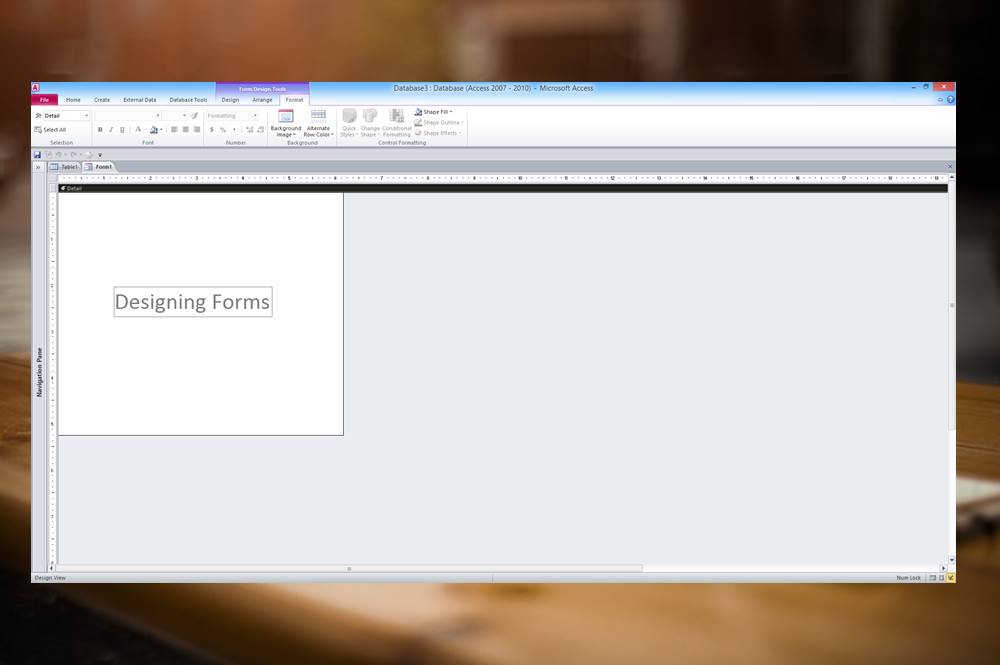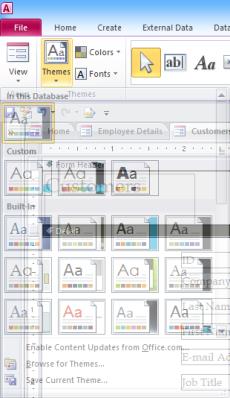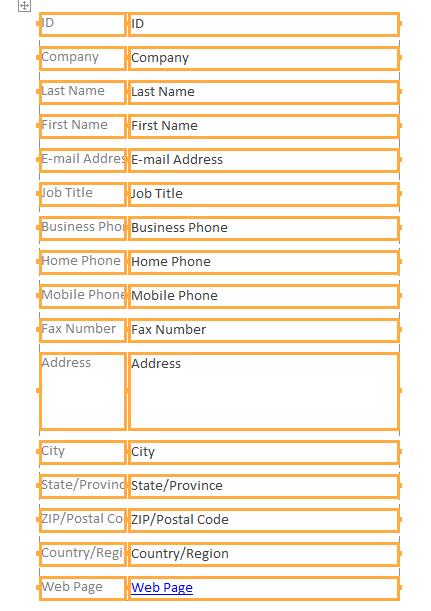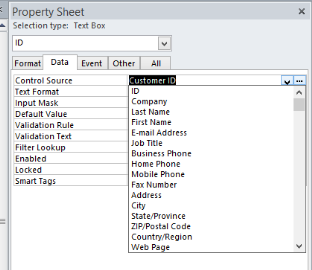Useful Strategies for Creating Microsoft Access Forms in Design View
Posted by: Avantix Learning Team | Updated October 14, 2022
Applies to: Microsoft® Access® 2010, 2013, 2016, 2019, 2021 and 365 (Windows)
You'll save a lot of time in Microsoft Access if you can select, move and format controls quickly and easily. Check out the following tips to save time when you're designing forms in Access in Design View.
Recommended article: 10 Timesaving Shortcuts in Microsoft Access
Do you want to learn more about Microsoft Access? Check out our virtual classroom or live classroom Access courses >
Use themes for formatting
Instead of selecting controls and formatting by manually changing fonts and colors, consider using themes instead. Themes consist of fonts and colors and are applied to the entire form. You can achieve a consistent look across you database if you use themes for both forms and reports.
To apply a theme:
- In Design View, click the Design tab on the Ribbon.
- Click Themes. A menu appears.
- Select a theme (overall theme). You can also select Colors and select a color theme or Fonts and select a font theme.
Remove controls from control layouts
Microsoft introduced control layouts in Access 2007. A control layout acts as a container. Objects in a control layout can only be moved within a control layout which can be frustrating for some Access users.
Below are controls in a control layout. Notice the icon on the top left.
To remove all controls from a control layout:
- In Design View, click a control in a control layout. An icon should appear on the top left of the control layout.
- Right-click a control in the control layout. A menu appears.
- Choose Layout and then Remove Layout.
Move controls separately
When you create a form, controls are usually placed on a form in pairs. For example, a text box has an associated label that is attached to it. If you move the text box, typically the label moves with it. To move a control without its associated control in Design View, drag either control by the top left handle. If this doesn't work, the control is in a control layout.
Separate controls
If you want to separate 2 controls such as a label and associated text box:
- In Design View, click the label (which is typically the control on the left).
- Press Ctrl + X to cut it.
- Click in an empty area on the form.
- Press Ctrl + V to paste.
Select all
You can select all controls on a form, by pressing Ctrl + A. If this doesn't work, make sure the Pointer or Selection tool is selected on the Design tab in the Ribbon.
Select by Shift-clicking
You can select specific controls by Shift-clicking on each control. If this doesn't work, make sure the Pointer or Selection tool is selected on the Design tab in the Ribbon.
Select by dragging
Ensure the Pointer or Selection tool is selected on the Design tab in the Ribbon. Drag around the controls you wish to select.
Nudge controls
You can nudge a control or control layout in Design View. Select the control or control layout and press Ctrl + arrow keys.
Add a control for an existing field
You can add a control for an existing field in the source:
- In Design View, click Add Existing fields in the Design tab on the Ribbon. A list of fields in the source appear.
- Drag the field onto the form.
Deal with the Name error
In Form View, if #Name? appears for a control (not all controls), the most common issue is that a bound control such as a text box is not bound to an existing field. This often happens when a user types in a text box.
To attach or bind a field to a control:
- In Design View, click the control that displays the #Name? error n Form View.
- Display the Properties if necessary. You can right-click the control and choose Properties from the menu or press F4 to display properties.
- In the Properties, click the Data tab.
- From the Control Source drop-down menu, choose an existing field.
You can use these 10 strategies when you're designing reports in Access as well.
This article was first published on February 7, 2016 and has been updated for clarity and content.
Subscribe to get more articles like this one
Did you find this article helpful? If you would like to receive new articles, join our email list.
More resources
How to Filter a Report on the Fly in Microsoft Access
10 Tips for Creating Select Queries in Microsoft Access
How to Convert a Microsoft Access Report to PDF (3 Ways)
How to Create a Calculated Field in a Microsoft Access Query
How to Highlight Records or Values in a Microsoft Access Report Using Conditional Formatting
Related courses
Microsoft Access: Introduction
Microsoft Access: Designing and Automating Forms >
Microsoft Access: Designing Queries and Reports >
Microsoft Access: Introduction to VBA (Visual Basic for Applications)
Our instructor-led courses are delivered in virtual classroom format or at our downtown Toronto location at 18 King Street East, Suite 1400, Toronto, Ontario, Canada (some in-person classroom courses may also be delivered at an alternate downtown Toronto location). Contact us at info@avantixlearning.ca if you'd like to arrange custom instructor-led virtual classroom or onsite training on a date that's convenient for you.
Copyright 2024 Avantix® Learning
You may also like
How to Replace Zeros (0) with Blanks in Excel
There are several strategies to replace zero values (0) with blanks in Excel. If you want to replace zero values in cells with blanks, you can use the Replace command or write a formula to return blanks. However, if you simply want to display blanks instead of zeros, you have two formatting options – create a custom number format or a conditional format.
What is Power Query in Excel?
Power Query in Excel is a powerful data transformation tool that allows you to import data from many different sources and then extract, clean, and transform the data. You will then be able to load the data into Excel or Power BI and perform further data analysis. With Power Query (also known as Get & Transform), you can set up a query once and then refresh it when new data is added. Power Query can import and clean millions of rows of data.
How to Freeze Rows in Excel (One or Multiple Rows)
You can freeze one or more rows in an Excel worksheet using the Freeze Panes command. If you freeze rows containing headings, the headings will appear when you scroll down. You can freeze columns as well so when you scroll to the right columns will be frozen.
Microsoft, the Microsoft logo, Microsoft Office and related Microsoft applications and logos are registered trademarks of Microsoft Corporation in Canada, US and other countries. All other trademarks are the property of the registered owners.
Avantix Learning |18 King Street East, Suite 1400, Toronto, Ontario, Canada M5C 1C4 | Contact us at info@avantixlearning.ca










